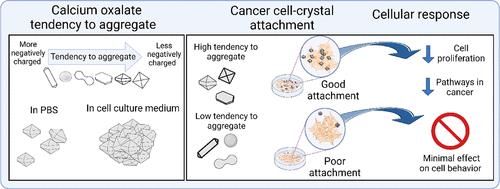Calcium Oxalate Crystals with a Bipyramidal Morphology and a High Tendency to Aggregate Attach Directly to Breast Cancer Cells and Affect Their Phenotype
IF 8.2
2区 材料科学
Q1 MATERIALS SCIENCE, MULTIDISCIPLINARY
引用次数: 0
Abstract
Various types of crystal can form in our bodies under normal and pathological conditions, with the more harmful of these crystals being studied intensively. However, much less is known about calcium oxalate dihydrate (COD) crystals, which are commonly associated with benign conditions. In general, calcium oxalates are pathological biominerals found in kidney stones and as microcalcifications (MCs) in breast and thyroid cancers. In breast cancer MCs, COD crystals are exclusively associated with benign lesions, and we have recently shown that they suppress breast precancer progression in vitro. Here, we studied the influence of synthetic calcium oxalate crystals─both COD and calcium oxalate monohydrate (COM)─with different morphologies and properties on crystal–cell interactions. We found that the less negatively charged crystals exhibited a greater tendency to aggregate and, as aggregates, attach better to cells, particularly to the cells of an invasive breast cancer cell line. We did not find any association between crystallinity, surface area, and solubilities of the crystals and attachment to cells. The crystal types that did attach efficiently to the cells, namely, COD with a thin or thick bipyramidal morphology, had the greatest impact on cell phenotype and functionally delayed cell growth, most probably through contact inhibition. Notably, in terms of morphology and size, these crystals resembled COD MCs found in benign breast tissues, suggesting that they are involved in a mechanism of tumor suppression.

具有双锥体形态和高聚集倾向的草酸钙晶体直接附着在乳腺癌细胞上并影响其表型
在正常和病理状态下,我们的身体会形成各种类型的晶体,对这些晶体中更有害的晶体进行了深入的研究。然而,人们对草酸钙二水合物(COD)晶体知之甚少,它通常与良性疾病有关。一般来说,草酸钙是一种病理生物矿物质,存在于肾结石和乳腺癌和甲状腺癌的微钙化(MCs)中。在乳腺癌MCs中,COD晶体只与良性病变相关,我们最近发现它们在体外抑制乳腺癌前期进展。在这里,我们研究了不同形态和性质的合成草酸钙晶体(COD和一水草酸钙(COM))对晶体-细胞相互作用的影响。我们发现,负电荷较少的晶体表现出更大的聚集倾向,并且作为聚集体,更好地附着在细胞上,特别是浸润性乳腺癌细胞系的细胞上。我们没有发现结晶度、表面积和晶体的溶解度与细胞附着之间的任何联系。有效附着在细胞上的晶体类型,即具有薄或厚双锥体形态的COD,对细胞表型的影响最大,并在功能上延迟细胞生长,最可能是通过接触抑制。值得注意的是,在形态和大小方面,这些晶体与良性乳腺组织中的COD MCs相似,表明它们参与肿瘤抑制机制。
本文章由计算机程序翻译,如有差异,请以英文原文为准。
求助全文
约1分钟内获得全文
求助全文
来源期刊

ACS Applied Materials & Interfaces
工程技术-材料科学:综合
CiteScore
16.00
自引率
6.30%
发文量
4978
审稿时长
1.8 months
期刊介绍:
ACS Applied Materials & Interfaces is a leading interdisciplinary journal that brings together chemists, engineers, physicists, and biologists to explore the development and utilization of newly-discovered materials and interfacial processes for specific applications. Our journal has experienced remarkable growth since its establishment in 2009, both in terms of the number of articles published and the impact of the research showcased. We are proud to foster a truly global community, with the majority of published articles originating from outside the United States, reflecting the rapid growth of applied research worldwide.
 求助内容:
求助内容: 应助结果提醒方式:
应助结果提醒方式:


